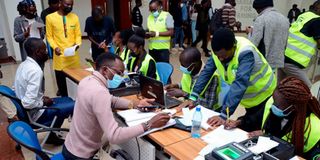Open the gates for the young to be leaders

Independent Electoral and Boundaries Commission (IEBC) officials register students of the University of Nairobi (UoN) as voters on October 13, 2021 during the launch of a voter registration drive in institutions of Higher Learning held at UoN Towers.
What you need to know:
- Older generations of Kenyan leaders have been huge proponents of the future tense when speaking about youth.
- Older leaders should use their power and influence to innovate and maintain new opportunities for young people.
One in four Kenyans, or 25 per cent of the total population, is aged between 18 and 34, with a further 43 per cent aged 15 and younger. This comes to a total of 68 per cent or two-thirds of the country. One would therefore expect that leadership in the country would be directly representative of more young people, and that public policies would be more targeted towards tangible welfare and quality of life improvement for the majority of the population; the young.
This, however, is not the case. Statistics collected by the InterParliamentary Union show that globally, MPs aged under 30 are 2 percent of total members. In Africa, a leader in this area is the Republic of the Gambia in West Africa, which per 2018 statistics had about 10 per cent of its MPs aged under 30, with Tunisia and Ethiopia also in the top 20 countries, at 6 percent. Kenya begins to show up in lists that have several MPs under 40 and 45, which, while relatively young for our context, still isn’t a fair reflection of Kenya’s demographics.
Older generations of Kenyan leaders have been huge proponents of the future tense when speaking about youth, discussing their leadership as something coming tomorrow. However, this leadership never actually arrives. This enables them to buy time to occupy power and leadership for longer, which then leads to the kind of skewed representations we are faced with today. Further to this, older leaders passively or actively created these barriers, then later bemoan the absence of young leaders, or even exceptionalism for the few who choose a political path as outliers who exist outside the norm.
Power and influence
For this to change, older leaders should use their power and influence to innovate and maintain new opportunities for young people to have the ability to lead in decision making at a political level. The political aspirations of the young must be recognised and listened to. Older leaders can do this fast by critically examining the attitudes and beliefs they hold that have made political engagement hard for youth, both as candidates and as voters.
Secondly, young people should be listened to in their full diversity. Phrasing like “youth and women”, for instance, assume that “youth” are always men, and “women” will tend to be older, making young women entirely invisible. Older leaders must ensure that they convene diverse young people groups when collecting views from the public, and in every gathering, find out how many young people came, and ensure sustained engagement within youth-focused safe spaces. Thirdly and relatedly, advisers who assist their decision making with research and debates must include young people.
It is crucial that young people are an exigent part of decisions that affect their welfare in all arenas — political, social and economic can no longer be disregarded. Leaders from older generations must thus ensure this participation and move from being gatekeepers.
The writer is a policy analyst. [email protected]





